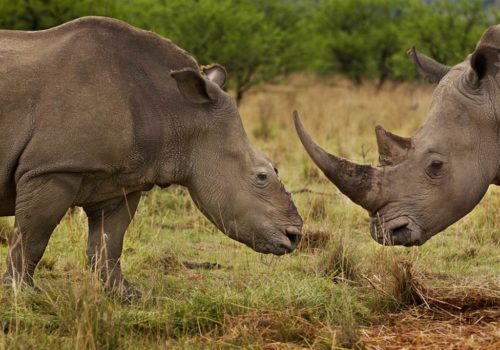Rhino Wars – Brent Stirton / Reportage by GETTY IMAGES for National Geographic
Currently one rhinoceros is killed by poachers every 16 hours in South Africa. Over the last three years, more than a thousand of these animals have been slaughtered. In response, police gunned down 22 poachers and arrested more than 200 in 2011. At the bloody heart of this conflict is the rhino’s horn, a prized ingredient in traditional Asian medicines. Though black market prices vary widely, as of last fall dealers in Vietnam quoted prices ranging from $33 to $133 a gram, which at the top end is double the price of gold and can exceed the price of cocaine.
Although the range of the two African species—the white rhino and its smaller cousin, the black rhino—has been reduced primarily to southern Africa and Kenya, their populations had shown encouraging improvement. In 2007 white rhinos numbered 17,470, while blacks had nearly doubled to 4,230 since the mid ’90s. For conservationists these numbers represented a triumph. In the 1970s and ’80s, poaching had devastated the two species. Conservation groups were able to convince several consuming nations to crack down on the sale of rhino horn, including China and Yemen. Now, however, much of the trade centers on Vietnam, where rhino horn has been recently rumored to be used as a traditional treatment for cancer.
Meanwhile, in South Africa, attracted by spiraling prices—and profits—crime syndicates began adding rhino poaching to their portfolios. Rhinos have been targeted on private game ranches, provincial reserves, and especially in the country’s vast Kruger National Park. South African authorities have responded by sending military units to bolster patrols and instituting a shoot-poachers-on-sight policy. Private activists have responded to the crisis, helping train and equip game rangers and boosting education campaigns in communities that live close to wildlife.
Amid all these efforts to combat poaching, some game farmers are questioning the international ban on selling rhino horn. They point out that unlike elephant ivory, rhino horn can be sustainably harvested without hurting the animals and that the horns will grow back fully in two years. Allowing the sale of responsibly harvested horn would make the animals attractive to farmers, who would be incentivized to invest in better security, and legalized trade would allow prices to stabilize and decrease speculation.
In the meantime, the killings continue, the carcasses pile up, and the world’s rhino population shrinks toward oblivion.
**Peter Gwin, who authored National Geographic’s story, is writing a book entitled Rhino Wars: A Journey into the Violent Underworld of Black Market Medicine, to be published in Fall 2012.
Brent Stirton
Brent Stirton is a 42 year old South African Photographer with an extensive history in the documentary world. Brent’s work has been published by: National Geographic Magazine, Time Magazine, Smithsonian Magazine, The Discovery Channel, Newsweek, The New York Times Magazine, The London Sunday Times Magazine, Le Express, Le Monde 2, Figaro, Paris Match, GQ, Geo, Stern, CNN, and many other international titles.
Brent is the official photographer for the Global Business Coalition against Aids, Tuberculosis and Malaria. He has been a long time photographer for WWF, the World Wide Fund for Nature, shooting campaigns on sustainability and the environment. He works for the Ford and Clinton Foundations, the Nike foundation and the World Economic Forum. He has photographed the Davos exhibition for the annual conference of world leaders in Switzerland for the last 6 years. He has been on the board of the Young Global leaders, a wing of the World Economic Forum for 5 years. He is also a Canon Ambassador, one of 12 photographers representing Canon photography.
Brent has received awards from the Overseas Press Club, the Frontline Club, the Deadline Club, Days Japan, The Pictures of the Year competition, China International Photo Awards, the Lead Awards Germany, Graphis USA, American Photography, American Photo and the American Society of Publication Designers as well as the London Association of Photographers. He has been regularly selected for the Communication Arts Photography annual. Brent has received 6 awards from the Lucie Foundation including International photographer of the Year. He has won 5 awards from the World Press Photo Foundation and has also received 2 awards from the United Nations for his work on the environment and in the field of HIV. He has won the Visa D’or at the Visa Pour L’ image Festival in France for Magazine photography. He also won the National Magazine Award for his work in the Congo for National Geographic Magazine.
Brent co-produced a documentary on Virunga National Park in conflict for National Geographic Television as well as appearing in the show. The documentary won the Emmy for Best Documentary Feature as well as a Bafta Award for Best Documentary.
His work has appeared in numerous print shows around the world and his images are in the collection of the National Portrait Gallery in London, the Museum of Modern Art in New York as well the Johannesburg Museum of Modern Art. He has been most recently exhibited in a solo show in conjunction with Elton John Aids foundation in Kiev, Ukraine in November 2011.
















